 | 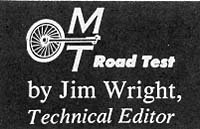 Top-selling Impala offers a full range of engine options. |
 |  Top-selling Impala offers a full range of engine options. |
| NOT TOO MANY years back, the prospective new-car buyer had very little to choose from when it came to what kind of an engine he wanted in his car. Some manufacturers were offering only one basic engine; others had two -- either a Six or a V-8 - but power options were unheard of.
This meant the buyer either had to be satisfied with what he could get or he could go the usual (and expensive) "hop-up" route at his local speed shop. Nowadays, the new-car buyer can get just about any degree of performance he wants, right from the factory. Most of the manufacturers are offering engine options ranging from mild to wild -- and no one offers any more than Chevrolet. |
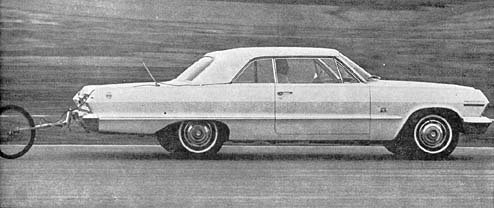
| At present, they have four basic engines: a 250-cubic inch Six and three V-8s of 283, 327, and 409 cubic inches (a 425-incher is still in the rumor stage). The Six is strictly their economy model, rated at 140 hp. The "283" pulls 195 hp and, together with the "327," available with either 250 or 300 hp, helps fill the gap between the economy Six and the all-out performance "409." The big ones come in three stages of tune: 340 and 400 hp for "street" use and 425 hp for drags only.
Since we had tested the "283" and the drag version of the "409" last year (July MT), we decided to find out what Chevrolet was offering in between. One of the test cars was equipped with the 250-hp "327," and the other had the newly introduced 340-hp "409." Both were Impala SS sport coupes (the only two-door hardtops now available are in the Impala series). Surprisingly enough, the Impala, which is the higher-priced series, has become the largest seller in the Chevrolet line. Being the SS, or Super Sport versions, both Impalas were equipped with bucket-type seats, padded dash, center storage console, and floor-mounted Powerglide control lever. |
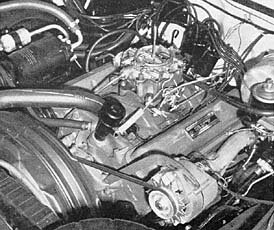 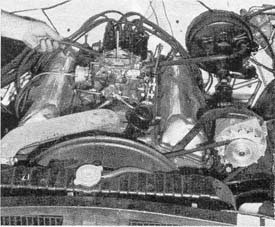 |
| External differences between the two engines are evident at a glance. Internally, "327" and "409" are also completely different. Chrome dress-up kit comes as standard equipment with "409." The Delcotron alternating generator is now standard. |
| Both engines were equipped with single four-barrel carburetors and hydraulic camshafts. The "327" had the higher compression ratio at 10.5 to 1, against the "409's" 10 to 1. Both require premium-grade fuel.
Since this is the first year that Chevrolet has mated one of their big engines with the Powerglide automatic transmission, we were especially interested in trying the "409" with this option. Standard rear axle with the "327" Powerglide is 3.08 to 1; with the "409" Powerglide, it's 3.36 to 1. Power steering and power brakes were installed on both test cars. The "327" also had air conditioning, power seat and windows. The "409" has a dash-mounted, 6000-rpm tachometer as standard equipment. The aluminum-cased Powerglide is now used on all passenger cars and has undergone slight modification from last year's. The "409" Powerglide embodies several heavy-duty components beyond those employed in the "327." One obvious difference was in the ratio of the internal gears. The "327" uses a 1.76-to-1 unit, while the modified "409" transmission uses last year's 1.82-to-1 gearset. |
 Fuses for lights and accessories are mounted on this easily accessible panel located beneath dash. |
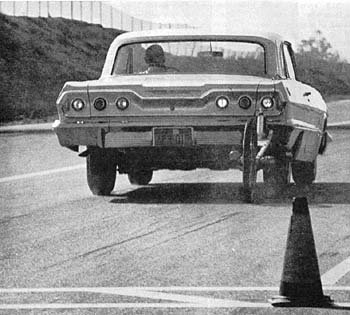 Except for a normal amount of fade, the Chevrolet brakes performed very well during our tests. A minimal amount of nosedive was encountered, even during very hard panic stops. |
| The two-speed transmission handled the output of the "409" quite creditably. There seemed to be a minimum of slippage between the low to high shifts, although the actual shift wasn't as quick and positive as we'd have liked. The standard Powerglide is set to upshift under full throttle at 4500 rpm, while the modified "409" unit shifts at 5000 rpm. Even though the "409" had a higher (numerically) rear axle, both cars upshifted at 62 mph. This was due to
the differences in transmission gearing, plus larger tires on the "409."
The floor-mounted shift lever is convenient, but we felt it could stand several improvements. First, even after putting over 1000 miles on these cars, we still had trouble determining what gear we were choosing, because the lever didn't line up with the indicator marks on the console. Also, even though a slight zig-zag action is required to get the lever from one position to another, it's very easy to slam the stick directly from LOW to REVERSE. Indicator lights would also help the driver shift at night. In addition to Powerglide, both engine options are also available with three- and four-speed manual transmissions. Three-speed with overdrive isn't available with these particular engines. Both cars performed very well in the acceleration tests. The "327," with a curb weight of 3829 pounds and a test weight of over 4200 pounds, was still able to log a 10.4 second 0-60-mph time. Zero-to-30 and 0-45 mph took 4.1 and 7:0 seconds, while the standing quarter-mile was run in 17.8 seconds, with a top speed of 78 mph. The "409" was, of course, much quicker to all the marks. It reached 88 mph in the quarter, with a 15.9-second elapsed time. The 0-30, 0-45, and 0-60-mph fractions were run through the watches at 3.0, 5.1, and 7.7 seconds. |